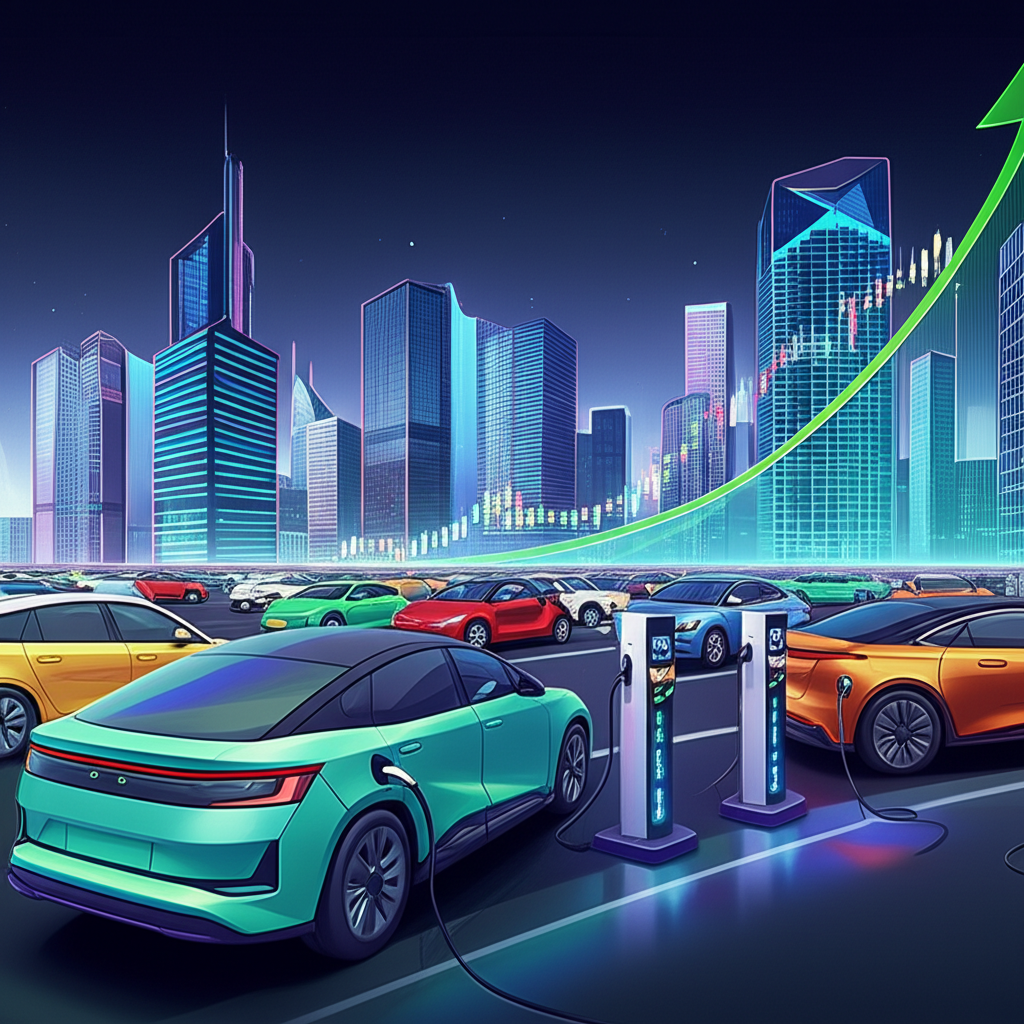Introduction: Powering Your Portfolio with EV Battery Stocks

The electric vehicle revolution is no longer on the horizon—it’s already accelerating at full speed. As automakers pivot from combustion engines to electrified platforms, entire industries are being reshaped in its wake. At the epicenter of this transformation is a single, powerful component: the EV battery. More than just a power source, it defines an electric car’s range, efficiency, and cost structure. For investors, the rising demand for EVs presents a strategic opportunity to gain exposure through EV battery stocks. From global manufacturing leaders to cutting-edge innovators and essential raw material suppliers, companies across the battery value chain are positioned to benefit from the shift toward sustainable mobility. This comprehensive guide will walk you through the key players, technological trends, investment considerations, and risks so you can make informed decisions and harness the momentum powering the future of transportation.
Why Invest in EV Battery Stocks Now? The Electrifying Growth Story

The momentum behind EV battery stocks isn’t just driven by hype—it’s rooted in tangible, long-term structural shifts. A powerful combination of technological progress, shifting consumer behavior, and aggressive government policies is creating a favorable environment for sustained growth. As battery performance improves and costs decline, electric vehicles are becoming more accessible and appealing to a broader audience. This expanding market creates a direct tailwind for companies involved in battery development, manufacturing, and raw material supply.
Global EV Adoption Trends and Projections
Electric vehicle adoption has entered a phase of exponential growth. In 2023 alone, over 14 million new electric cars were sold worldwide, capturing 18% of the global car market—a significant leap from just a few years ago. According to the International Energy Agency (IEA), this trend is expected to accelerate, with EVs accounting for more than one in three vehicles sold globally by 2030. In developed markets, that figure could rise to two out of every three cars by 2035. This level of adoption will require an unprecedented scale-up in battery production, making investment in battery-related companies a forward-looking play on long-term demand. As urban centers push for cleaner air and countries commit to net-zero emissions, the trajectory for EVs—and their batteries—remains firmly upward.
The Critical Role of Batteries in the EV Ecosystem

If electric vehicles are the future of transportation, then batteries are their beating heart. They represent the most expensive component in an EV, often accounting for 30–40% of the vehicle’s total cost. Beyond cost, batteries directly influence driving range, charging speed, safety, and longevity. As automakers race to produce longer-range, faster-charging, and more affordable models, the pressure to innovate in battery technology intensifies. Companies that lead in energy density, cost reduction, and manufacturing scale are not just supporting the EV revolution—they are shaping it. Investing in battery manufacturers is therefore not a peripheral bet, but a direct alignment with the core technology enabling electrification.
Government Incentives and Infrastructure Development
Policy support is a major catalyst behind the EV boom. Governments across North America, Europe, and Asia are implementing aggressive incentives to accelerate the transition. In the United States, the Inflation Reduction Act (IRA) has become a game-changer, offering tax credits for EVs assembled domestically and requiring a growing percentage of battery components and critical minerals to be sourced from the U.S. or its free trade partners. Similar policies in the European Union and China are encouraging localized production and reducing reliance on foreign supply chains. At the same time, massive investments in public charging networks are addressing one of the biggest consumer concerns—range anxiety. As infrastructure expands, EV ownership becomes more practical, further fueling demand and strengthening the investment case for EV battery companies.
Key Factors to Evaluate Before You Buy EV Battery Stocks
While the growth story is compelling, investing in EV battery stocks requires careful analysis. The sector is dynamic, capital-intensive, and highly competitive. To separate long-term winners from speculative ventures, investors should assess several critical factors before committing capital.
Technological Innovation & R&D Leadership
Innovation is the lifeblood of the battery industry. The race is on to develop batteries that offer higher energy density, faster charging, longer lifespans, and improved safety. Companies that consistently invest in research and development—and demonstrate a clear roadmap for next-generation technologies—are more likely to maintain a competitive edge. Whether advancing lithium-ion chemistries like LFP and NCM, pioneering solid-state solutions, or exploring new materials, technological leadership often translates into pricing power, better margins, and long-term market share. Investors should closely examine a company’s R&D spending, patent portfolio, and partnerships with research institutions or automakers.
Supply Chain Control and Raw Material Access
The EV battery supply chain begins deep underground. Lithium, nickel, cobalt, manganese, and graphite are essential to modern battery production, and their availability and pricing can significantly impact profitability. Companies with direct access to mining assets, long-term supply agreements, or vertical integration into refining and processing are better insulated from price swings and geopolitical disruptions. For example, lithium prices have experienced wild fluctuations in recent years, affecting margins across the industry. Additionally, companies investing in recycling technologies—recovering valuable metals from used batteries—are positioning themselves for a circular economy, reducing dependency on raw material imports and aligning with environmental goals.
Manufacturing Capacity and Scalability
Having a great battery design means little without the ability to produce it at scale. Gigafactories—massive facilities dedicated to battery production—are the backbone of the EV supply chain. Companies with established manufacturing footprints, high production yields, and plans for expansion are better equipped to meet surging demand. Scalability also ties directly to cost efficiency: larger production volumes typically lead to lower per-unit costs through economies of scale. Investors should evaluate not only current output but also announced capacity expansions, automation levels, and geographic diversification of manufacturing sites to assess a company’s long-term scalability.
Financial Health and Valuation Metrics
Even the most innovative company can struggle if its financial foundation is weak. A strong balance sheet, consistent revenue growth, positive cash flow, and manageable debt levels are all indicators of financial resilience. For high-growth battery stocks, profitability may still be years away, but operational efficiency and funding stability are crucial. When assessing valuation, metrics like Price-to-Sales (P/S), Enterprise Value to EBITDA, and Price-to-Book (P/B) can offer insights, especially for pre-profit companies. While high multiples are common in growth sectors, investors should be cautious of valuations that appear disconnected from fundamentals, particularly in speculative segments of the market.
Partnerships and Strategic Alliances
Success in the EV battery space often depends on collaboration. Battery makers frequently form joint ventures with automakers, co-develop technologies, or sign long-term supply agreements. These partnerships reduce uncertainty, secure future revenue, and provide access to engineering expertise and capital. For example, a battery company with a multi-year contract to supply a major automaker gains predictable cash flow and credibility. Similarly, alliances with raw material suppliers or recycling firms can strengthen supply chain resilience. A robust network of strategic relationships signals market confidence and enhances long-term viability.
Top EV Battery Stocks to Consider for Your Portfolio
The EV battery landscape offers a diverse range of investment opportunities, from dominant manufacturers to emerging innovators and critical material suppliers. Understanding the different segments can help investors build a balanced and forward-looking portfolio.
Established Market Leaders
These companies have already secured a leading position in the global battery market, with proven technologies, large-scale production, and major automaker clients.
* **CATL (Contemporary Amperex Technology Co. Limited):** As the world’s largest EV battery manufacturer, CATL commands a dominant share of the global market. Headquartered in China, the company supplies batteries to Tesla, BMW, Volkswagen, and numerous other automakers. CATL’s competitive advantages include massive manufacturing capacity, leadership in lithium iron phosphate (LFP) technology, and significant investments in sodium-ion and solid-state batteries. Its strong government support and global expansion plans make it a cornerstone player in the industry.
* **LG Energy Solution (LGES):** A South Korean powerhouse, LGES is a top-tier supplier of lithium-ion batteries for EVs, energy storage, and consumer electronics. With major partnerships including General Motors, Hyundai, and Stellantis, LGES has built a global manufacturing presence in the U.S., Europe, and Asia. The company is also investing heavily in next-generation technologies, including high-nickel and solid-state batteries, to maintain its technological edge.
* **Panasonic Holdings Corporation:** Long known as Tesla’s primary battery partner, Panasonic remains a key player in the cylindrical battery space. While facing increased competition, the company continues to innovate, particularly in 4680 cell development and manufacturing efficiency. Its new joint ventures in North America aim to strengthen its foothold in the U.S. market and align with IRA requirements for domestic production.
Promising Pure-Play Battery Innovators
These companies are focused exclusively on developing next-generation battery technologies, offering high-risk, high-reward potential.
* **QuantumScape Corporation (QS):** Based in the U.S., QuantumScape is developing solid-state batteries with a unique anode-free design. Backed by Volkswagen, the company aims to deliver batteries with significantly higher energy density, faster charging (up to 80% in 15 minutes), and improved safety. While still in the pre-revenue, R&D-intensive phase, successful commercialization could position QuantumScape as a major disruptor in the EV space.
* **Solid Power Inc. (SLDP):** Another U.S.-based innovator, Solid Power is working on sulfide-based solid-state batteries in collaboration with Ford and BMW. The company’s technology promises to eliminate flammable electrolytes, reduce reliance on cobalt, and improve performance in extreme temperatures. Solid Power has already delivered prototype cells to its partners, and pilot production lines are underway, bringing it closer to real-world deployment.
Key Raw Material Suppliers
Investing in raw material providers offers indirect exposure to battery demand while highlighting the importance of the upstream supply chain.
* **Albemarle Corporation (ALB):** A global leader in lithium production, Albemarle operates mining and processing facilities in Chile, Australia, and the U.S. With lithium being a critical input for nearly all EV batteries, Albemarle’s position as a top supplier gives it significant leverage. The company is expanding capacity and investing in lithium extraction innovation, including direct lithium extraction (DLE) technologies that could reduce environmental impact and improve efficiency.
* **Lithium Americas Corp. (LAC):** Focused on developing large-scale lithium projects in North America, LAC is advancing the Thacker Pass mine in Nevada—one of the largest known lithium deposits in the U.S. With growing demand for domestically sourced materials under the IRA, LAC is strategically positioned to support U.S. battery manufacturing. The project has faced regulatory and environmental scrutiny, but successful development could make LAC a key player in North American supply chain independence.
Diversified Industrial Giants with Battery Segments
These companies have broad operations but are making significant strides in the EV battery space.
* **Samsung SDI Co. Ltd.:** A subsidiary of the Samsung Group, Samsung SDI produces high-performance battery cells for EVs, consumer electronics, and energy storage systems. The company supplies major European automakers like BMW and Stellantis and is expanding its North American footprint. Known for its prismatic cell technology and focus on safety, Samsung SDI continues to invest in high-nickel and solid-state battery development.
* **BYD Company Limited (BYDDY):** A rare vertically integrated player, BYD designs, manufactures, and sells both electric vehicles and batteries. Its proprietary “Blade Battery,” based on LFP chemistry, has gained widespread acclaim for its safety and durability, even passing rigorous nail penetration tests. As one of the top EV sellers globally, BYD benefits from internal demand for its batteries while also supplying third parties, giving it a unique advantage in cost control and innovation speed.
| Company | Primary Focus | Key Technology/Strength | Market Cap (Approx.) | Key Partners |
|---|---|---|---|---|
| CATL | EV Battery Manufacturing | LFP & NCM, High Volume | $100B+ | Tesla, BMW, VW, Ford |
| LG Energy Solution | EV Battery Manufacturing | NCM & NCMA, Global Footprint | $60B+ | GM, Hyundai, Stellantis |
| Panasonic | EV Battery Manufacturing | Cylindrical Cells, R&D | $20B+ | Tesla |
| QuantumScape | Solid-State Batteries | Anode-free solid-state | $3B+ | Volkswagen |
| Albemarle | Lithium Production | Global Lithium Mining & Processing | $15B+ | Battery Manufacturers |
| BYD | EV Manufacturing & Batteries | Blade Battery (LFP), Vertically Integrated | $80B+ | Mercedes-Benz |
Beyond Lithium-Ion: Investing in Next-Generation Battery Technologies
While lithium-ion batteries dominate today’s market, the future of EV power is likely to be more diverse. Next-generation technologies promise to overcome current limitations in cost, safety, charging speed, and resource availability. Investors who understand these emerging trends can position their portfolios ahead of the curve.
Solid-State Batteries: The Holy Grail of EV Power
Solid-state batteries are widely seen as the next major leap in energy storage. By replacing the liquid electrolyte in conventional batteries with a solid material, these systems offer higher energy density, faster charging, longer cycle life, and significantly improved safety—no risk of leakage or thermal runaway. Companies like QuantumScape and Solid Power are at the forefront, with automakers like Volkswagen, Ford, and Toyota investing heavily in their development. The main hurdles remain manufacturing complexity and cost, but if these can be overcome, solid-state batteries could redefine the EV experience within the next decade.
Sodium-Ion Batteries: A Cost-Effective & Abundant Alternative
Sodium-ion technology is emerging as a practical complement to lithium-ion, especially for entry-level EVs and grid storage. Sodium is far more abundant and cheaper than lithium, reducing material costs and supply chain risks. While current energy density is lower, rapid advancements are closing the gap. CATL has already launched sodium-ion batteries for commercial vehicles and two-wheelers, and other manufacturers are exploring hybrid systems that combine sodium and lithium cells. For investors, sodium-ion represents a near-term opportunity to capitalize on cost-sensitive markets without sacrificing performance entirely.
Other Emerging Chemistries (e.g., LFP advancements, Manganese-rich)
Innovation isn’t limited to entirely new battery types. Lithium iron phosphate (LFP) batteries, once considered low-performance, are seeing major improvements in energy density and cold-weather operation, making them ideal for mass-market EVs. Their lower cost and superior safety profile have led to widespread adoption by Tesla, BYD, and others. Meanwhile, researchers are developing manganese-rich cathodes to reduce reliance on expensive and ethically sensitive materials like cobalt and nickel. These incremental but impactful advancements highlight that even within the lithium-ion family, there’s still significant room for evolution.
Risks and Challenges in the EV Battery Stock Market
Despite the strong growth narrative, investing in EV battery stocks comes with notable risks. The sector is still maturing, and volatility is common. A balanced perspective is essential to avoid overexposure to hype or unforeseen setbacks.
Raw Material Price Volatility and Supply Chain Disruptions
The prices of lithium, nickel, and cobalt can swing dramatically due to mining output, geopolitical tensions, or changes in demand. For example, lithium prices surged in 2022 before correcting sharply in 2023, impacting margins across the supply chain. Companies without long-term supply contracts or diversified sourcing strategies are particularly vulnerable. Additionally, the concentration of processing in a few countries creates bottlenecks and strategic risks, especially in times of trade friction.
Intense Competition and Rapid Technological Obsolescence
The battery industry is fiercely competitive, with dozens of players from China, South Korea, the U.S., and Europe vying for market share. Technological leadership can be fleeting—today’s breakthrough can become obsolete in just a few years. Companies that fail to keep pace with innovation or scale efficiently may lose contracts and market position. This rapid pace demands constant R&D investment and operational agility

留言